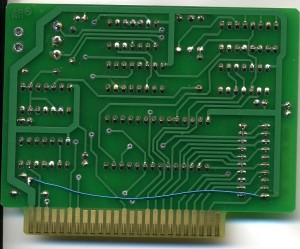It’s been a while since I found an Apple 1 program that didn’t run on the Brain Board/Wozanium, but there is a new program out for the Apple 1 that uses the ACI for audio out.
http://www.applefritter.com/content/8k-apple-i-ascii-graphics-lunar-lander-aci-audio-hack-0
Copied here, is my post on the Applefritter forum, describing the fix.
This program will not work as is, with versions Brain Board/Wozanium pack firmware less than version 5.2. There is an issue with the the gosubs 750s in the 900 range (at the end of the program). Those gosubs call directly into the original Cassette interface driver to generate sound. This driver is still present in the Wozanium PROM, but is incompatible with Apple II hardware and will crash the system.
There are several fixes available.
1) remove the call 750s at the end of the program. LInes 900 and 910.
2) Change the pokes in line 999 to call the Wozanium A2 cassette Driver at 0xd0d7:
999 POKE 750,169:POKE 752,32:POKE 753,215:POKE 754,208:POKE 755,96:RETURN
3) If you have a PROM burner, fix the Wozanium cassette driver to work with the A2 hardware by erasing a bit in the PROM – change location 0x01EA in PROM from 0xBC to 0xAC.
4) If you don’t have a PROM burner, send your board or prom back to me and I’ll erase the bit for you.
With fixes 2, 3 or 4 in place, you can attach a preamp to the cassette output of the Apple 2 and get the same sounds as if you were running on an actual Apple 1. It’s kind of funky because the A2 has a built in speaker, which is bypassed, but it works.
If you are running a Wozanium PROM image in an Apple II emulator either:
1) remove the call 750s at the end of the program. Lines 900 and 910.
2) change line 999 to call the Wozanium ACI driver at 0xd1d7:
999 POKE 750,169:POKE 752,32:POKE 753,215:POKE 754,209:POKE 755,96:RETURN
Finally if you don’t have a preamp for the cassette output, there is an inexpensive design on my website that will work for this application.
http://www.willegal.net/preamp/preamp.htm

